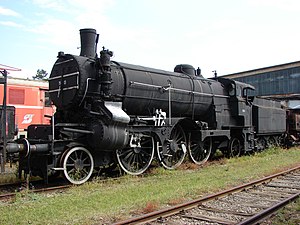kkStB 10
| kkStB 10 / BBÖ 10 / DR 15 / ÖBB 15 | |
|---|---|
|
ÖBB 15.13 in the Strasshof Railway Museum
|
|
| Numbering: | kkStB 10.01–19 BBÖ 10.01–19 DR 15 001–019 ÖBB 15.01–19 (with gaps) |
| Number: | kkStB: 19 BBÖ: 19 ÖBB: 15 |
| Manufacturer: | StEG , Wr. Neustadt , BMMF |
| Year of construction (s): | 1909-1910 |
| Retirement: | until 1956 |
| Axis formula : | 1'C1 'h4v |
| Gauge : | 1435 mm ( standard gauge ) |
| Length over buffers: | 17,962 mm |
| Length: | 14,584 mm |
| Height: | 4,585 mm |
| Total wheelbase: | 9,490 mm |
| Service mass: | 73.7 t |
| Friction mass: | 45.9 t |
| Top speed: | 90 km / h |
| Driving wheel diameter: | 1,820 mm |
| Impeller diameter front: | 1,034 mm |
| Rear wheel diameter: | 1,034 mm |
| Number of cylinders: | 4th |
| HD cylinder diameter: | 390 mm |
| LP cylinder diameter: | 630 mm |
| Piston stroke: | 720 mm |
| Boiler overpressure: | 15 atm |
| Number of heating pipes: | 157 |
| Number of smoke tubes: | 24 |
| Heating pipe length: | 5,272 mm |
| Grate area: | 3.67 m² |
| Radiant heating surface: | 13.00 m² |
| Tubular heating surface: | 176.30 m² |
| Superheater area : | 65.1 m² |
| Tender: | 9 , 56 , 156 , 256 , 76 , 86 , 88 |
| Control: | Heusinger |
The steam locomotive series kkStB 10 was a fast - Tender Lokomotiv series of kk Austrian National Railways (kkStB).
Between 1909 and 1910, 19 units were procured from the StEG locomotive factory , the Wiener Neustädter Lokomotivfabrik and the Bohemian-Moravian machine factory . The 1'C1 'h4v type, designed by Karl Gölsdorf , was more powerful as a superheated steam locomotive than the predecessor type 110 . The logical designation 210 was already occupied by a 1'C2 'design. The 10 series knew how to impress with their performance, but their running characteristics were not convincing because of their leading Adam axle . Their maximum speed was therefore set at 90 km / h.
The first locomotives were stationed in Salzburg , the others in Villach and Vienna West.
The 10.18, the 5000th locomotive delivered by the Wiener Neustädter Lokomotivfabrik, was given a sheet metal boiler cladding with brass straps and a steam dome clad with brass. It was considered the Austrian court train locomotive .
The Deutsche Reichsbahn took over all the machines in 1939 and designated them as the 15 series . From then on they were in service in Linz . In May 1945 the first locomotive was cashed in, presumably because of war damage. In 1953, 15 locomotives were taken over by the ÖBB with the numbers 15.01 to 15.19. By June 1956, the series was almost completely decommissioned, 15.13 was the last to be in use after that and was used as a heating system from 1960 and was stored for the Railway Museum in 1969. The locomotive was later installed at the Technical Museum in Vienna, and since 1999 it has been in the Strasshof Railway Museum in Lower Austria .
For the sake of completeness, it should be noted that the numbers 10.01-09 were already assigned by the kkStB earlier, for locomotives of the Rudolfsbahn (KRB), which were given the series designation 22 in 1891 and finally in 1904 the designation 122 .
literature
- Johann Blieberger, Josef Pospichal: The kkStB traction vehicles . tape 1 . Rows 1 to 228. bahnmedien.at, 2008, ISBN 978-3-9502648-0-7 .
- Karl Gölsdorf: Locomotive construction in old Austria 1837–1918 . Slezak publishing house, Vienna 1978, ISBN 3-900134-40-5 .
- Helmut Griebl, Josef Otto Slezak, Hans Sternhart: BBÖ Lokomotiv-Chronik 1923–1938 . Slezak publishing house, Vienna 1985, ISBN 3-85416-026-7 .
- Heribert Schröpfer: Locomotives for Austrian railways - steam locomotives BBÖ and ÖBB . alba, Düsseldorf 1989, ISBN 3-87094-110-3 .
- Johann Stockklausner: Steam company in old Austria . Slezak Verlag, Vienna 1979, ISBN 3-900134-41-3 .
- Dieter Zoubek: Preserved steam locomotives in and from Austria . Self-published, 2004, ISBN 3-200-00174-7 .
